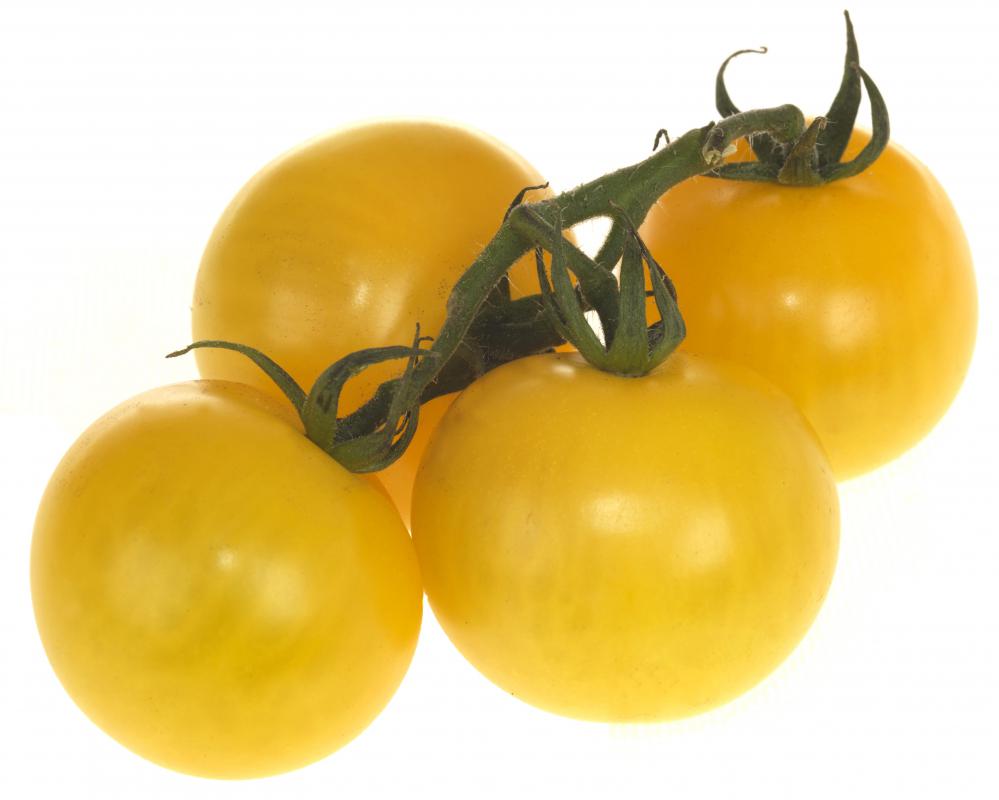At AllThingsNature, we're committed to delivering accurate, trustworthy information. Our expert-authored content is rigorously fact-checked and sourced from credible authorities. Discover how we uphold the highest standards in providing you with reliable knowledge.
What is the Mediterranean Fruit Fly?
The Mediterranean fruit fly is a tropical fruit fly from Africa, though it is found as an invasive species in other parts of the world. It has established infestations in parts of Europe, South America, and the Caribbean, as well as in Hawaii since 1910. Owing to its ability to devastate crops, many governments have strict quarantines to ensure that it not establish new infestations, and they practice drastic eradication measures if the fruit fly’s presence is suspected.
The Mediterranean fruit fly damages more different types of plants than any other fruit fly. It is considered to be the most dangerous agricultural pest in the world. The U.S. Department of Agriculture estimates that, if the pest were to become established in the U.S., the agricultural costs could exceed $7 billion US Dollars (USD). The Mediterranean fruit fly infests more than 260 types of plants, including fruits, vegetables, and nuts. The worst damage from the infestations is generally found in citrus crops, peppers, and tomatoes.

Ceratitis capitata, the scientific name of the Mediterranean fruit fly, is smaller than a housefly. Commonly referred to as Medfly, the adult is yellow with a bit of brown on its legs, patterned wings, and purple eyes. The life cycle of the Mediterranean fruit fly is between 21 and 100 days, with the amount of time necessary depending on temperature and weather conditions.

The female fly lays one to 10 eggs to start the life cycle. The eggs are smooth, shiny, and white, and she deposits them under the skin of nearly ripe fruit. While reproductive, she may lay eggs 22 times per day and will lay an average of 300 eggs in her lifetime.
From these eggs, white larvae hatch and begin feeding on the fruit, where they remain for up to 26 days. They leave the fruit to pupate in nearby soil. The pupae from which the adult fly will emerge is red-brown in color. The time of pupation varies depending on temperature and weather conditions. Once it emerges, the adult will be fully mature and can start to reproduce within about three days.
In the U.S., the first infestation following that of Hawaii occurred in Florida in 1929. There have been several infestations in the country since then. Eradication and prevention programs have kept the Mediterranean fruit fly from becoming established on the mainland. Those who are traveling abroad or from Hawaii are not allowed to bring into the country products that might harbor the pest. These products include fresh fruits, meats, and birds.
Frequently Asked Questions
What is the Mediterranean Fruit Fly?
The Mediterranean Fruit Fly, or Medfly, is a small, destructive pest known for its wide range of host fruits. It's scientifically named Ceratitis capitata and is considered one of the world's most invasive fruit flies. Originating from Africa, it has spread to many parts of the world, causing significant damage to fruit crops by laying eggs inside the fruit, which hatch into larvae and feed on the pulp.
Why is the Mediterranean Fruit Fly considered a major agricultural pest?
The Medfly is a major agricultural pest because it infests over 300 types of fruits and vegetables, leading to extensive crop damage and economic loss. According to the University of California Statewide Integrated Pest Management Program, the Medfly can cause up to 100% crop loss if not controlled. Its presence often results in strict quarantine measures and trade restrictions to prevent its spread.
How do Mediterranean Fruit Flies reproduce and how quickly can they infest crops?
Mediterranean Fruit Flies reproduce by laying eggs under the skin of host fruits. A single female can lay up to 800 eggs in her lifetime. These eggs hatch into larvae within a few days, which then feed on the fruit, causing it to rot. Rapid reproduction and development allow Medflies to infest crops quickly, with generations overlapping in warm climates, leading to continuous infestations.
What methods are used to control or eradicate the Mediterranean Fruit Fly?
Control methods for the Medfly include bait sprays, sterile insect technique (SIT), biological control using natural predators, and quarantines. The SIT involves releasing sterile males to mate with wild females, resulting in no offspring, which reduces the population over time. According to the International Atomic Energy Agency, SIT is an environmentally friendly control method that has been successful in eradicating Medflies from several regions.
What impact does the Mediterranean Fruit Fly have on international trade?
The Mediterranean Fruit Fly significantly impacts international trade by prompting import restrictions and quarantine measures to prevent its spread. Infested countries may face bans on exporting susceptible fruits and vegetables, leading to economic losses. The Food and Agriculture Organization of the United Nations emphasizes the importance of monitoring and control measures to facilitate safe international trade of agricultural products.
Can the Mediterranean Fruit Fly survive in colder climates?
While the Mediterranean Fruit Fly thrives in warm climates, it can survive in colder regions during the warmer months. However, it is generally less able to establish permanent populations in areas with cold winters. According to research, temperature is a critical factor in Medfly distribution, and they are rarely found in regions where the temperature drops below the developmental threshold for extended periods.
AS FEATURED ON:
AS FEATURED ON:












Discuss this Article
Post your comments